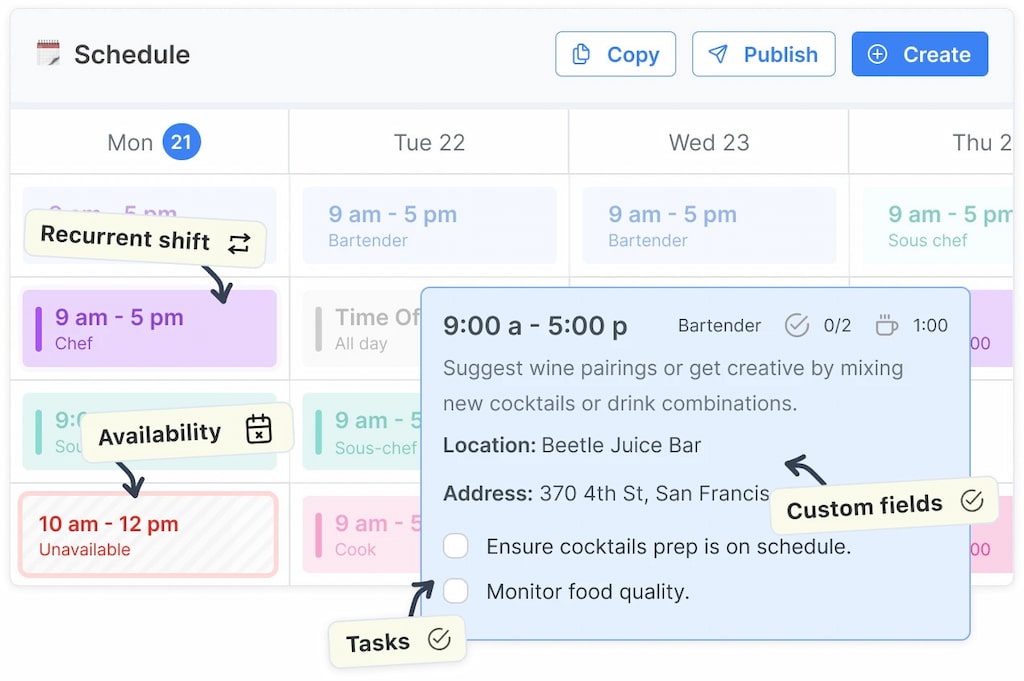In a world chasing flexibility, sometimes the old-school 9-to-5 still delivers. A fixed schedule—consistent schedule with start and end times every day—offers a stability that many crave. But is that consistency actually boosting morale, or trapping your team in rigid routines? Let’s explore what a fixed schedule really offers in 2025—how it shapes productivity, supports well-being, and fits into modern work culture.
🤔 Understanding a Fixed Schedule: Key Benefits & Drawbacks
What is a fixed schedule anyway?
It’s simple: every Monday through Friday, your team clocks in at the same hour, clocks out at the same hour. No surprises—just structure.
✅ Benefits at a glance
- Reliable routine helps staff plan deep personal lives.
- Steady productivity—no erratic peaks or troughs.
- Reduced stress—less uncertainty about hours.
- Easier teamwork—everyone available at the same time.
- Forecastable workflows for managers and HR.
⚠️ Drawbacks to watch
- Limited flexibility for unexpected life demands.
- Potential burnout if the schedule feels monotonous.
- Commute pressure at peak hours.
- Not for night owls—natural rhythms get ignored.
- Potential stifled creativity—rigid hours don’t suit every brain.
🧠 Examples of Fixed Schedules
Here’s how “fixed” plays out across different roles:
- Typical 9-to-5: Ideal in corporate and administrative settings.
- Part-time fixed shifts: E.g., Mon/Wed/Fri 10 AM–2 PM—fits caregivers or students.
- Healthcare shift rotations: Early, mid, or late fixed shifts to ensure coverage.
- Factory lines: Standardized hours drive machine and team flow.
These patterns map out predictability—help staff plan every single week.
🧐 How to Know if Fixed Scheduling Is Right for You
Here’s a quick decision checklist:
- 🔄 Nature of work: Routine, predictable tasks? Fixed fits.
- 🧑🤝🧑 Employee preferences: Do staff want structure or flexibility?
- ⏰ Customer hours: Do clients expect fixed availability?
- ⚙️ Operational efficiency: Is stability more valuable than agility?
- 📜 Legal & regulatory constraints: Does your industry mandate minimum rest or shift patterns?
- 🖥️ Technology readiness: Can automated tools help ease the burden?
If you circled “yes” to most, fixed scheduling might be your foundation. If not, a hybrid or flexible schedule could be smarter.
📚 Choosing a Fixed Schedule: Guide for Managers
🔄 1. Evaluate business needs
Map your busiest hours and staffing gaps. Fixed schedules only work if they cover demand.
🕒 2. Consider staff preferences
Run quick surveys or feedback sessions—do team members want predictable hours?
🧠 3. Pilot the model
Run a short test period with a small team. Track overtime, stress, and satisfaction.
🔧 4. Use smart tools
Ditch spreadsheets—tools like Shifts by Everhour automate schedules, time-off, and communication effectively.

🔍 5. Monitor & adapt
Review KPIs (punctuality, overtime, retention). Adjust start/end combined with snack breaks to support morale.
🔨 Tool Highlight: Shifts by Everhour
Shifts by Everhour is tailor-made for routine-based teams. Why it stands out for fixed schedules:
- 🔄 Auto-generates recurring shifts
- 📅 Publishes schedules well in advance
- 🔁 Handles PTO, shift swaps, and shift requests
- ⏱️ Integrates attendance and time tracking
- 🚀 Scales from small teams to full departments

Think of it as the modern alternative to color-coded wall boards—without the chaos.
❓ FAQs: Fixed Schedule
What is a fixed work schedule?
A set schedule with consistent start/end times and modifications only on exceptions.
Are fixed schedules still viable in remote work?
Absolutely—sets a shared “core hours” window and fosters collaboration.
What if staff want flexibility over structure?
Balance is key—mix fixed core hours with flexible edges.
Do fixed schedules reduce burnout?
They can, if they include proper breaks and allow staff to disconnect outside work hours.
How do I transition from flexible to fixed?
Run a pilot, collect feedback, and use scheduling tools to enforce consistency.
🔎 Final Thoughts
Fixed schedules may seem old-fashioned, but when managed thoughtfully, they deliver outcomes: stability, clarity, and team cohesion. The key lies in using modern tools like Shifts by Everhour to balance predictability with empathy—and deliberately build routines that serve everyone.
Your next step: pilot a fixed schedule in one department, monitor how it affects engagement and performance for 60 days, and iterate. With the right balance, structure doesn’t have to be restrictive—it can be liberating.
If you’re looking for a seamless way to improve shift planning, Shifts by Everhour is the perfect solution and one of the most powerful When I Work alternatives. With features like real-time monitoring, easy scheduling, and mobile accessibility, managing your workforce has never been simpler.
There’s always a possibility for self-service scheduling if your employees decide to do so!

